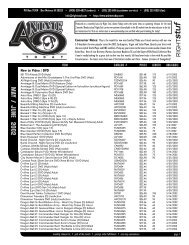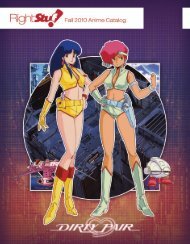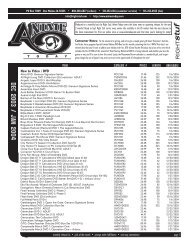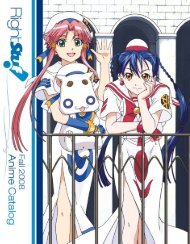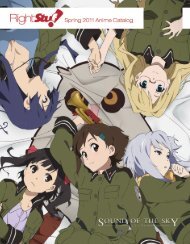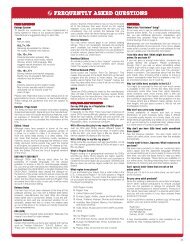06 Fall Catalog Book2.indb - Right Stuf
06 Fall Catalog Book2.indb - Right Stuf
06 Fall Catalog Book2.indb - Right Stuf
You also want an ePaper? Increase the reach of your titles
YUMPU automatically turns print PDFs into web optimized ePapers that Google loves.
Here at <strong>Right</strong> <strong>Stuf</strong>, we pride ourselves on<br />
being a fan-oriented company – when we<br />
release a show, we want to present it as well<br />
as we possibly can. But in the summer of<br />
2004, we were given our greatest challenge<br />
yet: To Heart.<br />
For those new to the show, To Heart is a romance series that aired in Japan back in early 1999.<br />
It’s based on one of the most popular Japanese dating sims of all time: Aqua Plus’ To Heart. So<br />
as you can imagine, the series is fi lled with numerous pretty girls – but it doesn’t get up caught in<br />
the stereotypical traps of modern-day harem anime. There is no “spineless male lead” or “abusive<br />
female love interest” here. The characters in To Heart have realistic emotions, and as they live, love<br />
and grow, we get to take every step with them.<br />
THE HARD WORK<br />
And so in 20<strong>06</strong> work fi nally began! This is the stage we’re in now – carefully going through each episode, frame by frame,<br />
and repairing a lot of the problems in the original print. Paying close attention to every scene change, we inspect each<br />
frame for spots, dirt, grit, glue, or any other large debris, and through the magic of the digital world, we’re able to restore<br />
the video to a virtually spotless condition.<br />
We’re also working hard to reduce the aforementioned frame jitter seen in the show. This has proven to be one of the more<br />
diffi cult aspects of restoration, because many of the cels were not only off-center vertically or horizontally, but they were<br />
also distorted when they were captured to fi lm. To fi x this, we need to fi nd a group of clean, centered frames that look<br />
identical to the damaged frames, and use those to replace the damaged set. It’s not an easy task!<br />
On these pages, you’ll see a few examples of glue and dirt that have been removed. The frame jitter fi xes are a bit harder<br />
to show in print form, but if you watch the old version and the new side-by-side, the improvement is startling.<br />
THE RESULTS<br />
Well, that’s up to you – the fans – to judge! This past August, we debuted the fi rst fully-restored episode of To Heart at<br />
Otakon to much success; and we hope that when you pick up a copy next spring, you’ll be just as pleased.<br />
We’ll be glued to our computers until this release is ready to go, so see you next spring, anime fans!<br />
Judy DeFrieze<br />
Assistant Producer<br />
Unfortunately, while those in Japan already knew To Heart from the video game, our US audience<br />
was unlikely to have ever heard of the series. In order to build an audience, we decided to release<br />
To Heart’s sister series fi rst: Comic Party. Absolutely fi lled with references and cameos to To Heart,<br />
Comic Party was a comedy series that mainstream fans could easily identify with, and it became very<br />
successful in the States. Finally, we knew the time was right to bring To Heart to English-speaking<br />
anime fans everywhere! There was just one little problem… the video quality of the masters we<br />
received was so poor that we simply couldn’t release it.<br />
LESSONS ON FILM<br />
BEFORE<br />
AFTER<br />
BEFORE<br />
Although most anime today is sketched and then scanned into computers and stored digitally, To<br />
Heart was created before the big digital revolution – it was sketched and then traced onto handpainted<br />
cels and captured completely on fi lm. After all the capture was done, the editor stepped in<br />
and spliced, or glued, all of the various pieces of fi lm together to create the fi nal version of the show.<br />
It was a pretty regular process in the animation industry back then.<br />
Unfortunately for To Heart, two things happened during this process. First, sometimes the cels<br />
weren’t aligned properly when they were being captured to fi lm… which means that the image<br />
seems to move or jitter slightly on-screen. Second, the adhesive used during the splicing process<br />
seems to have been rather inexpertly applied, and thus every time a scene changes, there are giant<br />
blobs of white along the top or bottom of the frame. This looks like damaged fi lm, but it’s actually the<br />
glue they used to patch the fi lm back together!<br />
AFTER<br />
Of course, then there are also all the typical problems associated with shows produced on fi lm: over<br />
time, the fi lm itself begins to degrade, forming visible spots, along with a build up of dust and dirt.<br />
One of the best ways to repair all of these issues is to do a complete fi lm restoration. However, we<br />
quickly learned that that would be impossible – the original To Heart fi lm masters were destroyed<br />
years ago, so the materials we had now were all we were going to get. Unwilling to settle, our<br />
search for a way to restore the video began.<br />
THE GREAT RESTORATION SEARCH<br />
One of the most time-consuming parts of the To Heart restoration project wasn’t the<br />
actual restoration at all – it was fi nding a good way to restore the video in the fi rst<br />
place! Without the original fi lm source, all the corrections were going to have to be<br />
done digitally. There’s a lot of great video restoration software out there used by big<br />
Hollywood studios – but unfortunately they have price tags that only a big Hollywood<br />
studio could pay. Cheaper programs could fi x some of the issues, but would also<br />
cause washed out color or video distortion. We didn’t want to trade one set of<br />
problems for another.<br />
But after a long search, the solution was found! We came across a great software<br />
suite that would require us to do a bit more by hand, but the output was clean, which<br />
was just what we were looking for.



